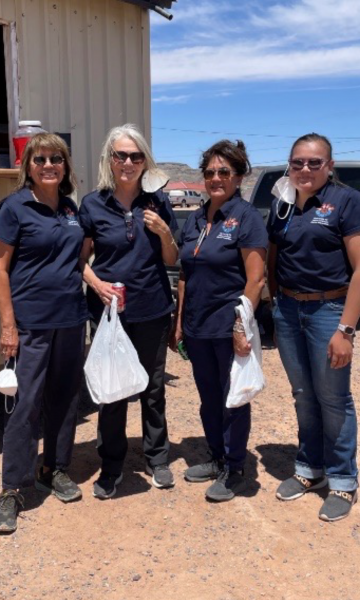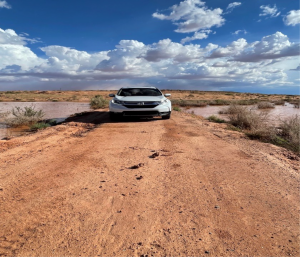
How can you eliminate a pervasive, yet undiscussed, bacterial infection from the Navajo Nation? For a collaborative group of researchers, it requires dedication, hours of travel, and unfailing commitment to present information in a respectful, culturally relevant way.
Helicobacter pylori, known as H. pylori, is one of the most common bacterial stomach infections worldwide and accounts for nearly three-quarters of all gastric cancer.
While gastric cancer has decreased in the United States, the incidence in the Navajo Nation is nearly four times higher than non-Hispanic white populations in the area.
In a recent publication, “Helicobacter pylori Prevalence and Risk Factors in Three Rural Indigenous Communities of Northern Arizona,” researchers from the University of Arizona, Northern Arizona University and San Diego State University explored the results of a study on H. pylori they conducted from June to August 2018.
The team recruited 106 self-identified Navajo adults 18 years and older from 73 households living in three Navajo chapter communities in the southwestern part of the Navajo Nation in Arizona. Their results found that 56.4% of study participants had H. pylori and 72% of households had at least one infected person.
Robin B. Harris, professor of epidemiology in the UA Mel & Enid Zuckerman College of Public Health, was the principal investigator. Other researchers included Heidi E. Brown, infectious disease epidemiologist in the UA Department of Epidemiology and Biostatistics; Rachelle L. Begay, a doctoral student in epidemiology and senior program coordinator in the Center for Indigenous Environmental Health Research in the UA Mel & Enid Zuckerman College of Public Health; Priscilla R. Sanderson (Diné), professor in the NAU Department of Health Sciences; Carmenlita Chief (Diné), senior research coordinator in the NAU Center for Health Equity Research; Fernando P. Monroy, professor in the NAU Department of Biological Sciences; and Eyal Oren, associate professor of Division of Epidemiology and Biostatistics, San Diego State University.
“The devastation of stomach cancer is a primary reason for the NACP-funded team to know the causes of Helicobacter pylori infection,” Sanderson said. “In addition, the NAU team conducted semi-structured interviews to explore the knowledge, attitudes, and behaviors of Navajo adults on Navajo Nation and in urban areas surrounding the Navajo Nation (AZ, NM, UT, CO). The NAU team are members of Navajo Nation so our work is personal as we want to save lives for our Diné extended family.”
Exploring H. pylori through the Navajo Healthy Stomach Project
In 2017, researchers from UA and NAU formed the Navajo Healthy Stomach Project, through the Partnership for Native American Cancer Prevention (NACP), to determine the prevalence of H. pylori infection among Navajo adults and to identify the local social, behavioral, and environmental factors associated with infection.
According to the National Institutes of Health, H. pylori infection usually occurs in childhood. The infection can increase the chance that a person may develop gastric cancer.
H. pylori bacteria are usually passed from person to person through direct contact with saliva, vomit or stool and may also be spread through contaminated food or water, crowded living conditions or living with someone who has H. pylori.
H. pylori study

Data gathering teams included undergraduate Diné students from NAU; medical, doctoral, a master’s degree and undergraduate Diné students from UA; an undergraduate from Diné College; and Navajo community health representatives. At least one member of each team was fluent in Navajo. The teams used GPS to locate and personally visit 143 households on the Navajo Nation. They were able to recruit participants from just over half of the households they encountered.
“It was essential [to include someone on the team who was fluent in Navajo] because these three communities we had worked with on this on this study are located in a part of the Navajo Nation that is pretty rural, where more households speak Navajo as their primary language and live several miles away from a paved road,” Chief said. “So, if you are investing 30 to 45 minutes traveling on a dirt road to get to a home, you want to make sure someone on the team can communicate effectively with household members once you get there. In many cases, those are our elders.”
The teams explained the study to participants, administered the surveys and collected specimens. In the survey, participants described their water sources, food preparation procedures, refrigeration practices, bathroom configuration, lifestyle behaviors, dietary habits, and health history.
Each participant also took a non-invasive C-Urea Breath Test, which detects the presence of H. pylori in expelled breath; specimens were analyzed by machine at the Winslow Indian Health Care Center in Winslow, AZ.

After the researchers mailed the results to participants, a Navajo CHR visited every person to make sure they received their test results and provided additional education to them.
They found H. pylori in 66 participants of the 101 viable UBT tests; —78% were male and 57% were female. The odds of having H.pylori increased for households with unregulated water, and the Navajo Healthy Stomach Project identified water sources as a primary environmental or household risk factor for infection.
Future for the Navajo Health Stomach Project
The Navajo Healthy Stomach Project also found that there was generally a low level of awareness of H. pylori, with only 24% of the participants reporting they had ever heard of the infection.
Their future work will address barriers that prevent people who test positive for H. pylori from getting treatment and expand education through medical centers for earlier diagnosis.
Since the H. pylori infection typically begins in childhood or early adulthood, the researchers said they hope to develop a follow-up study to target participants under the age of 18 and to expand the number of participants in the 18–29 age range.
The team plans to continue to explore the causes of H. pylori, with a goal of eradicating the disease and to address unregulated water for drinking and cooking.
“We are hopeful our Navajo Nation leaders will assist in our effort as this is a public health concern that needs to be addressed and prioritized as we want our Navajo extended family to see stomach cancer rate reduced to zero—just like the rest of America,” Sanderson said.
The Partnership for Native American Cancer Prevention (NACP) is the collaboration between The University of Arizona Cancer Center (UACC), Northern Arizona University (NAU), The National Institutes of Health (NIH), and The National Cancer Institute (NCI). The Partnership is funded under parallel grants, U54CA143924 (UACC) and U54CA143925 (NAU).